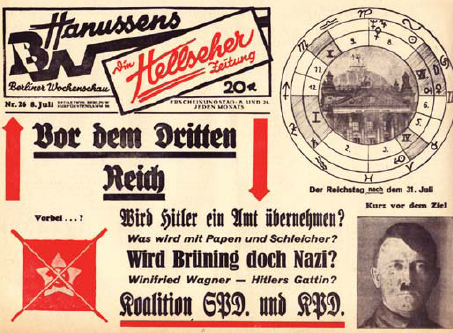
The Nazi occult legend predates the war, coming into its own alongside the Nazis themselves. Various “Aryan mystics” claimed the Nazi Party was predestined, even mythic, but the theory of occult, conspiratorial forces intertwined with the rise of the Third Reich first explicitly appeared in a novel entitled Les Sept Têtes du Dragon Vert (The Seven Heads of the Green Dragon; 1933) by a French journalist (and possible French spy) named Pierre Mariel. A number of other French publications elaborated on this theme during the 1930s, culminating in Edouard Saby’s Hitler et les Forces Occultes (Hitler and the Occult Forces; 1939). That same year, the disenchanted German politician Hermann Rauschning published Gespräche mit Hitler (Conversations with Hitler; UK title Hitler Speaks) a book describing Hitler’s encounters with “the new man” of quasi-Theosophist lore, and his “bondage to … evil spirits.” With the outbreak of war in September 1939, the “occult Reich” theory reached the English press in Lewis Spence’s The Occult Causes of the Present War (1941). The actual business of fighting slowed down such speculations, but the concept re-emerged in Louis Pauwels and Jacques Bergier’s Le Matin des Magiciens (The Morning of the Magicians; 1960) and Trevor Ravenscroft’s The Spear of Destiny (1972), both of which sold millions of copies and spawned hundreds of imitators, all of which reconstruct and emphasize each others’ larger claims while contradicting each others’ details. This pattern will be familiar to historians in other fields.
This book attempts to synthesize and systematize a history of the Nazi occult. It draws, as far as possible, on the work of serious historians both of the occult and of German intellectual and political history. Where documentation or firm evidence exists, this text does not depart from it. But as the great historian Sir Hugh Trevor-Roper (himself an authority on both Nazism and the occult) observed, writing history is inevitably an act of imaginative reconstruction. In this field, where so little has been uncovered by academic research, imagination – mine or other authors’ – is a necessity. Just as the history of some ancient land, where only one or two archaeologists have dug, must rely on myth, legend, and folktales, for now so too the history of the Nazi occult must incorporate those elements of its mythology most likely to reflect actual events. In some places I have resorted to extrapolation and interpolation; in almost all places I have been required to choose between divergent narratives.
One narrative I can reject. Hitler was not an occultist. He had little patience for Himmler’s Ariosophist obsessions, repeatedly condemning them in private conversation and public speech. He despised astrology, although he was willing to use it as propaganda, and was suspicious of all secret societies. His conceptions of race and history were operatic, even mystical at times, but he was no mystic. He was willing to accept Hörbiger’s World Ice Theory as legitimate astrophysics, mostly on poetic grounds, but he mocked notions of Atlantis or giants. His beliefs were pragmatic, as befit a street-brawling politician. The Holocaust was not a sorcerous ritual. It was a political mass murder, driven by National Socialist ideology. That ideology was shaped by Ariosophy, but also by the trauma of World War I and by the theories of leading scientists like Haeckel and philosophers such as Nietzsche and Schopenhauer. The occultists who surrounded Hitler, and who took advantage of the suspension of both morality and skepticism in his regime, used those killings for their own ends, but they did not engineer them. They did not have to.

The front page of Hanussens Berliner Wochenschau (July 8, 1932) depicts the horoscope of the Reichstag, showing dangers and mishaps after the end of July, and correctly predicting the Nazi percentage of the upcoming vote. Hanussen also predicted (correctly) that Hitler would not join the government, that the socialists and communists would fail to unite, and that Hitler would not marry the composer’s daughter-in-law Winifred Wagner. His final successful prediction in this issue: “The National Socialists will remain at the helm in the foreseeable future. Supported by a robust militia, which is blindly devoted to their leader and highly disciplined, they will continue to field a force of great power. Their commitment and toughness is something the uninitiated cannot imagine.” (Mel Gordon Archive)
According to a 1943 US Office of Strategic Services (OSS) report, Hitler took “regular lessons in speaking and in mass psychology from a man named Hanussen, who was also a practicing astrologer and fortuneteller.” Erik Jan Hanussen combined stage magic, mesmerism, séances, and the occult in varying degrees during his long career. By 1930, he was holding orgies and magical rituals in his “Palace of the Occult” with high-ranking members of the Sturmabteilung (Storm Detachment; SA). In 1932, he clairvoyantly predicted Hitler’s rise to power, earning him at least one meeting with the then-sidelined politician. Various sources say that he trained Hitler in mesmerism, broke a curse put on Hitler by an unknown magical enemy, and volunteered his own services as Director of the Occult in a Nazi government. When Hitler baffled onlookers by becoming chancellor in January 1933, Hanussen seemed on the verge of triumph.
Then, the night before the Reichstag Fire, Hanussen clairvoyantly predicted “a Great House consumed by flames.” Suddenly, The Man Who Was Never Wrong became The Man Who Knew Too Much. Hanussen’s real name came out: Hermann Steinschneider. The Danish magus was a Jewish fraud! He vanished on the way to a performance; his bullet-ridden body turned up in a shallow grave. On trial, the Reichstag fire arsonist, a simple-minded communist named Martin van der Lubbe, showed every sign of mesmeric control.